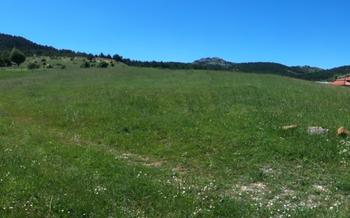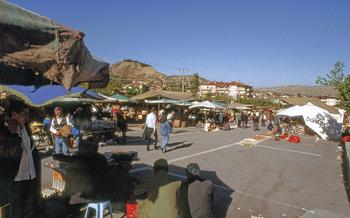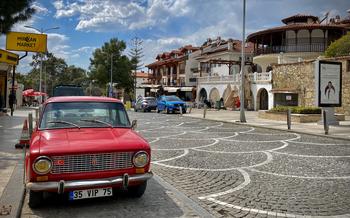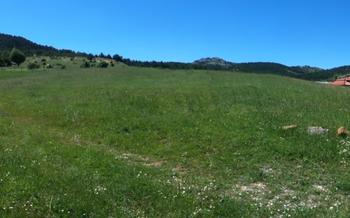
Çankırı Drahna Village Historical Ruins
- Çankırı Drahna Village Historical Ruins: A Journey Through Time
- Exploring the Ancient City of Drahna
- Marveling at the City Walls
- Discovering the Sacred Precinct
- Stepping into the Agora
- Experiencing the Theater
- Exploring the Necropolis
- Uncovering Archaeological Treasures
- Learning about the Hellenistic and Roman Periods
- Appreciate the Natural Beauty
- Engaging with the Local Community
- Supporting Local Businesses
- Preserving Cultural Heritage
- Planning Your Visit
- Insider Tip: Capture the Moment
Çankırı Drahna Village Historical Ruins: A Journey Through Time
Çankırı Drahna Village Historical Ruins offer a captivating glimpse into Turkey's rich past. Nestled near the city center, these ruins transport visitors back to the ancient eras of Hellenistic and Roman rule. Well-preserved structures, ongoing archaeological excavations, and scenic surroundings create an immersive experience for history enthusiasts, nature lovers, and culture seekers alike.
Historical Significance:
The Çankırı Drahna Village Historical Ruins hold immense historical significance. Dating back to the Hellenistic period, the ruins showcase architectural influences from various civilizations that ruled the region. The remains of temples, an agora, a theater, and a necropolis provide valuable insights into the urban planning, religious practices, and cultural exchanges of the ancient city of Drahna.
Location and Accessibility:
Conveniently situated just a short distance from the city center, the Drahna Village Historical Ruins offer easy accessibility for visitors. The scenic surroundings, featuring rolling hills, lush forests, and verdant greenery, further enhance the charm of this historical site. Whether exploring the ancient ruins or simply enjoying the natural beauty, visitors are sure to be captivated by the allure of this unique destination.
What to Expect:
As you step into the Drahna Village Historical Ruins, be prepared to marvel at the well-preserved structures that stand as testaments to ancient craftsmanship. Archaeological excavations are continuously underway, revealing new artifacts and shedding light on the daily lives and customs of the people who once inhabited this city. The ruins offer a fascinating glimpse into the past, inviting visitors to immerse themselves in the history and culture of ancient Turkey.
Tips for Visiting:
To make the most of your visit to the Çankırı Drahna Village Historical Ruins, consider the following tips:
- Best Time to Visit: Spring and autumn offer pleasant weather conditions for exploring the ruins. However, if you prefer fewer crowds, consider visiting during the off-season.
- Operating Hours: The ruins are generally open to the public daily. However, it's always advisable to check local sources for the most up-to-date information on operating hours.
- Admission Fees: There are usually nominal admission fees for visiting the ruins. These fees help support the ongoing preservation and maintenance efforts.
Exploring the Ancient City of Drahna
The ancient city of Drahna, nestled within the Çankırı Drahna Village Historical Ruins, holds a wealth of historical significance. Founded in the 3rd century BC, it flourished under Hellenistic rule and later became part of the Roman Empire. The city's strategic location along trade routes contributed to its prosperity and cultural diversity.
Drahna boasts several notable attractions, including its impressive city walls, sacred precinct, agora, theater, and necropolis. The city walls, with their sturdy gates and towers, once provided protection against invaders. The sacred precinct, dedicated to various deities, features well-preserved temples adorned with intricate columns, pediments, and friezes.
The agora, the bustling marketplace and social center of ancient Drahna, offers a glimpse into the city's vibrant commercial and civic life. Here, visitors can envision the lively interactions between traders, shoppers, and citizens engaged in political gatherings and public events.
The theater, a testament to Drahna's cultural sophistication, hosted theatrical performances, concerts, and spectacles. Its well-preserved seating arrangements, stage, and acoustics provide a tangible connection to the artistic expressions of the past.
Finally, the necropolis, located outside the city walls, reveals the burial practices and beliefs of the ancient inhabitants. Elaborate tombs, sarcophagi, and inscriptions offer insights into their social status, family structures, and afterlife beliefs.
Marveling at the City Walls
The city walls of Drahna stand as a testament to the city's strategic importance and enduring strength. Constructed to protect the city from invaders, these fortifications are a marvel of ancient engineering. Explore the massive gates, which once served as the main entrances to the city, and marvel at the towering towers that provided a vantage point for defenders. Notice the intricate construction techniques and the materials used, such as massive stone blocks and intricate brickwork. As you walk along the ramparts, imagine the fierce battles and sieges that took place here, and the resilience of the people who defended their city. For a breathtaking perspective, climb to the top of the walls and soak in the panoramic views of the surrounding countryside, a landscape that has witnessed centuries of history unfold.
Discovering the Sacred Precinct
At the heart of Drahna, discover the sacred precinct, a sanctuary dedicated to various deities. Step into this hallowed ground and marvel at the architectural wonders that have stood the test of time. Majestic columns rise towards the sky, supporting ornate pediments and intricate friezes. Altars, once used for offerings and rituals, stand as silent witnesses to the devotion of ancient worshippers.
As you wander through the sacred precinct, let your imagination transport you back in time. Picture the priests performing sacred rites, the smoke of incense filling the air, and the faithful kneeling in prayer. Each temple here holds its own unique story, revealing the rich mythology and religious practices of the ancient city.
Take your time to explore each temple, admiring the fine craftsmanship and attention to detail. Look out for inscriptions and carvings that may offer clues about the deities worshipped here and the rituals that took place within these sacred walls.
Insider tip: Visit the sacred precinct during sunrise or sunset to experience a magical atmosphere as the golden light casts long shadows across the ruins, creating a truly unforgettable sight.
Stepping into the Agora
The agora was the bustling heart of ancient Drahna, serving as both a marketplace and a social center. Here, locals gathered to buy and sell goods, exchange news, and participate in political discussions. The agora's layout was carefully designed, with colonnades lining the perimeter and shops and public buildings arranged in a grid-like pattern. As you walk through the agora, imagine the lively atmosphere of the ancient marketplace, with merchants hawking their wares, shoppers bargaining for the best prices, and citizens engaging in lively debates.
Experiencing the Theater
Step into the ancient theater of Drahna, a captivating venue that once hosted an array of performances, concerts, and spectacles. This well-preserved structure offers a glimpse into the cultural and entertainment life of the ancient city.
Marvel at the architectural features of the theater, including the carefully arranged seating arrangements, the elevated stage, and the remarkable acoustics that allowed performers to be heard throughout the venue.
Imagine the atmosphere of a performance, as actors took to the stage to entertain and captivate audiences with their theatrical skills. The theater served as a platform for cultural expression, bringing the community together for shared experiences of laughter, drama, and awe.
For an immersive experience, take a seat in the front row and let the ancient ambiance envelop you. Feel the energy of the performance as if you were transported back in time, witnessing the artistry and talent of the ancient performers.
Exploring the Necropolis
The necropolis, or ancient cemetery, of Drahna Village offers a glimpse into the burial practices and beliefs of its former inhabitants. Scattered around the site are tombs of various sizes and styles, reflecting the social status and family structures of the deceased. Many of the tombs feature intricate carvings and inscriptions, providing valuable insights into the lives and legacies of those buried within.
Insider Tip: Look for well-preserved tombs with elaborate carvings that depict scenes from mythology or everyday life. These tombs often provide the most fascinating glimpse into the beliefs and values of the ancient Drahna people.
Uncovering Archaeological Treasures
Çankırı Drahna Village Historical Ruins have been the subject of ongoing archaeological excavations, revealing a wealth of ancient artifacts that shed light on the daily life, trade, and cultural influences of the region. These excavations have unearthed a treasure trove of pottery, coins, tools, and jewelry, offering valuable insights into the past.
The pottery discovered at the site showcases a variety of styles and techniques, providing clues about the artistic traditions and craftsmanship of the ancient inhabitants. The coins bear the effigies of various rulers and deities, offering a glimpse into the political and religious landscape of the time. Tools and utensils provide practical evidence of everyday activities, such as cooking, farming, and construction. Jewelry, often adorned with intricate designs and semi-precious stones, hints at the personal adornment and social status of the people who once called this place home.
Visiting the Çankırı Museum, located in the city center, is a great way to view a selection of the excavated artifacts from Drahna Village. The museum's collection includes pottery vessels, coins, tools, and jewelry, as well as sculptures, inscriptions, and other artifacts from the region. These exhibits provide a tangible connection to the past, allowing visitors to appreciate the rich cultural heritage of Çankırı.
Learning about the Hellenistic and Roman Periods
The Çankırı Drahna Village Historical Ruins offer a glimpse into the Hellenistic and Roman periods, two significant eras that shaped the history and culture of the region. During the Hellenistic period, the city of Drahna flourished under the rule of the Seleucid Empire. This period saw the construction of many of the city's most impressive structures, including the city walls, temples, and theater. The influence of Hellenistic culture is evident in the architectural styles and decorative motifs found throughout the ruins.
In the 1st century BC, Drahna came under Roman rule. The Romans made significant additions to the city, including an agora, or marketplace, and a necropolis, or cemetery. The Roman period also saw the introduction of new cultural influences, such as Roman architecture and language.
The legacy of the Hellenistic and Roman periods can still be seen in Çankırı today. The ruins of Drahna are a testament to the rich cultural heritage of the region. By exploring these ruins, visitors can gain a deeper understanding of the history and significance of this ancient city.
Insider tip: Read up on the history of the Hellenistic and Roman periods before your visit to gain a deeper appreciation for the ruins. This will help you understand the context in which they were built and the role they played in the development of the city.
Appreciate the Natural Beauty
As you explore the historical ruins of Çankırı Drahna Village, take a moment to appreciate the stunning natural beauty that surrounds the site. The village is nestled amidst rolling hills, lush forests, and vibrant greenery, creating a picturesque backdrop for your visit. Embrace the tranquility of the natural surroundings as you wander through the ancient ruins, allowing the serenity of the landscape to enhance your historical exploration.
Engage in outdoor activities to fully immerse yourself in the natural wonders of the area. Embark on a revitalizing hike through the scenic trails, discovering hidden paths and breathtaking viewpoints. Find a secluded spot for a peaceful picnic, enjoying a delightful meal surrounded by the tranquility of nature. Observe the diverse local flora and fauna, spotting unique plant species and listening to the harmonious melodies of birdsong.
Whether you prefer the vibrant colors of spring, the warmth of summer, the crispness of autumn, or the serene stillness of winter, each season offers its own unique charm at Çankırı Drahna Village. Plan your visit during spring or autumn to experience the most favorable weather conditions and witness the landscape adorned in its most vibrant hues. Immerse yourself in the natural beauty of Çankırı Drahna Village, allowing the harmony of nature to complement your journey through history.
Insider tip: For an unforgettable experience, visit the village during sunrise or sunset. The warm glow of the golden hour casts a magical light upon the ruins, creating an ethereal atmosphere that enhances the beauty of the site.
Engaging with the Local Community
As you explore the ruins of Çankırı Drahna Village, take the opportunity to interact with the friendly locals. Their warm hospitality will make you feel welcomed and connected to the region's culture. Engage in conversations, learn about their daily lives, and share stories. Experience traditional crafts, such as carpet weaving or pottery making, and immerse yourself in the vibrant local music and dance. Don't miss the chance to savor the delicious regional cuisine, which showcases fresh, local ingredients and unique flavors. To truly connect with the locals, make an effort to learn a few Turkish phrases, such as "Merhaba" (hello) and "Teşekkür ederim" (thank you). These small gestures will go a long way in fostering meaningful interactions and creating lasting memories.
Supporting Local Businesses
Your visit to the Çankırı Drahna Village Historical Ruins not only offers an enriching historical experience but also presents an opportunity to support the local economy. By engaging with local businesses, you contribute to the preservation of traditional crafts, cuisine, and cultural heritage.
Insider tip: Visit the local market, where you can find unique handcrafted souvenirs and fresh local produce. This is a great way to experience the genuine culture of the region and support the livelihoods of local farmers and artisans.
Look out for locally produced honey, which is a specialty of the region. It is delicious, nutritious, and makes for a thoughtful gift.
When tasting the local cuisine, try the traditional Turkish gözleme, a savory flatbread filled with spinach, cheese, or minced meat. It's a delicious and authentic snack that will leave you wanting more.
Additionally, consider staying in local guesthouses or bed and breakfasts. This is a fantastic way to interact with the local community, learn about their way of life, and contribute to the local economy.
By supporting local businesses, you not only get to experience the authentic culture of the region but also contribute to its sustainability and preservation.
Preserving Cultural Heritage
As responsible travelers, we have a duty to preserve the cultural heritage of the places we visit. The Çankırı Drahna Village Historical Ruins are a precious reminder of the region's rich past, and it is our collective responsibility to protect them for future generations.
Respecting local guidelines and regulations is paramount. Follow designated paths, avoid touching or climbing on ancient structures, and refrain from removing any artifacts or plant life.
Sustainable tourism practices can contribute to the preservation of the ruins. Consider staying in locally-owned guesthouses, supporting initiatives that promote responsible tourism, and minimizing your environmental impact by reducing waste and conserving water and energy.
By raising awareness about the importance of cultural heritage and advocating for its preservation, we can ensure that the Çankırı Drahna Village Historical Ruins continue to inspire and captivate visitors for years to come.
Planning Your Visit
To make the most of your trip to the Çankırı Drahna Village Historical Ruins, proper planning is essential. Getting there is relatively straightforward; you can either drive or take public transportation. If driving, follow the signs to Çankırı and then to the village of Drahna. Public transportation options include buses from Çankırı city center, which depart regularly and drop you off near the ruins.
Accommodation is available in Çankırı city center, offering a range of options from budget-friendly guesthouses to comfortable hotels. Staying in the city center allows you to explore the ruins during the day and return to the comforts of modern amenities in the evening.
Guided tours are available for those who prefer a more structured experience. These tours typically cover the main highlights of the ruins and provide valuable insights into their history and significance. Guided tours can be booked through local tour operators or at the Çankırı Museum.
Finally, remember to check the weather forecast before your visit, as the weather in Çankırı can be unpredictable, especially during the winter months. Dressing appropriately will ensure you have a comfortable and enjoyable experience exploring the ancient ruins.
Insider Tip: Capture the Moment
Çankırı Drahna Village Historical Ruins offer a wealth of photographic opportunities, allowing you to capture the essence of this ancient city. Bring your camera or smartphone to document your visit and share your experiences with the world.
-
Composition: Experiment with different angles and perspectives to create dynamic compositions. Capture the ruins against the backdrop of the surrounding hills or focus on intricate details like carvings and inscriptions.
-
Lighting: The best time to visit for photography is during the golden hours of sunrise and sunset when the warm light casts a magical glow on the ruins.
-
Unique Perspectives: Venture off the beaten path to discover hidden corners and vantage points. Climb to the top of the city walls for panoramic views or explore the lesser-known parts of the necropolis to capture unique shots.
-
Storytelling: Your photographs should tell a story. Capture the ruins in their natural setting, with people interacting with the site or showcasing the local flora and fauna.
-
Sharing Your Experiences: Share your stunning photographs on social media using relevant hashtags to connect with other travelers and history enthusiasts. Your images can inspire others to explore this hidden gem and appreciate its historical significance.









